In this post we are discussing about Classification of Computers based on various aspects such as brand, size, application of computers, technology used and so on.
In digital computers, mathematical expressions are represented as binary digits (0 and 1) and all operations are done using these digits at a very high rate. It means that the computer operates on electrical inputs that have only two states, ON and OFF. These computers are widely used in commercial and control systems. Nowadays when we use the word computer, we mostly refer to a digital computer.
Show your love! Share this page!
Classification of Computers
In this chapter, we will look at classification of computers – the different types of computers based on different aspects.
Since the first computer, there are different types of computers. Some are to do specific task and some for general purpose – do everything a program can make it to do. Some computers work with continuous signals of the physical quantities such as pressure, temperature, speed, current etc. and some with discrete data or the digital signals. Some computers are really huge in size while others are as tiny that fit in our pockets and palm. There are computers from different companies that work totally different and some work similar to others. So, in this class we’ll try to identify the classes on which each computer can be grouped into – the classification of computers.
Classification of computers based on application
We can identify three different classes if we look upon how a computer works or what they are applied for – Analog, Digital and Hybrid computers.
Analog Computer
An analog computer is a form of computer that uses the continuously-changeable aspects of physical phenomena such as electrical, mechanical, or hydraulic quantities to model the problem being solved. These computers are used in Hospitals, Air-crafts and so on.
An analog computer can be mechanical analog computer or electronic analog computer. (There can be a confusion that electronic computers are digital but note that there are electronic analog computers too!)
Mechanical analog computers have existed for thousands of years, with the oldest known example being the Antikythera. This is a Greek machine, thought to have been made around 100 BC, designed for calculating astronomical positions. A more recent and common mechanical analog computer is the slide rule.

The HITACHI 240 Analog Computer
Digital Computer

Digital Computer
Digital computers are the most common class of computers for us because we are using them every day. Digital Computers can be defined as a computer that performs calculations and logical operations with quantities represented as digits, usually in the binary number system.
Hybrid Computers
Analog computers worked purely measuring the physical quantities whereas digital computers counted and manipulated the numbers to produce results. There is another class of computers that can take benefit of features of both these two classes, so, known as hybrid computers.
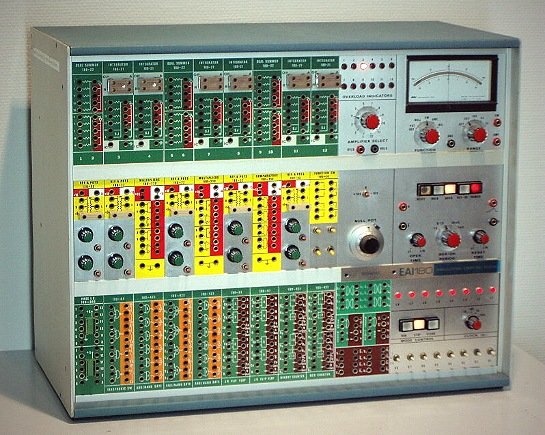
EAI 180 hybrid computer
Hybrid computers are computers with combined features of both digital and analog type. Desirable features of analog and digital machines can be combined to create a Hybrid Computer. This type of computer operates by counting as well as by measuring. In other words, the output can be either in the form of numbers or required units of measurement, e.g., an analog device measures patient’s heart beat (ECG). These measures will be converted into digital form and a digital device checks for any abnormality. Further, we can also input digital data like your marks and get digital results like the result of your class. Another example is a Modem. (which converts the digital signals into analog, carryitalongthelineandatthereceivingendagainchangesitbackintodigitalsignal).
If you are interested about the differences in analog, digital and hybrid computers, you are encouraged to visi thttp://www.answerbag.com/q_view/1602745.
Classification of computers based on size
We’ve already seen how large the computers were and these days we are using very small computers, some even embedded in wrist watch. So, another interesting aspect to classify computers is based on size. If we look at the computers from this perspective, we can group them into three major classes – Mainframe, Mini and Microcomputers.
Mainframe Computers

Mainframe Computer
These are very huge computers. It is interesting how the word ‘mainframe’ came into use. In fact, because the different units of computer were installed in a frame, it started to be called a computer in main frame and today classes of computers are called Mainframe computers.
Mainframe computers are very powerful computers with large memory and processing capabilities. It can support hundreds of users simultaneously.
Mini Computers
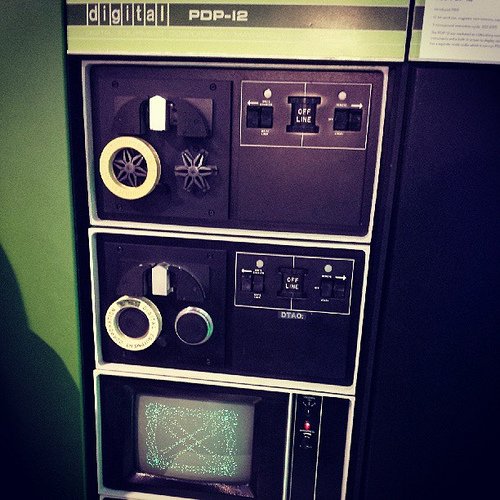
DEC PDP 12
Mini computers are medium sized computers – much larger than the personal computers we are using and smaller compared to the mainframe computers. These computers can support multiple users simultaneously and is less powerful than mainframe computers.
A Minicomputer was typically a standalone device that was ideal for use by small and medium sized businesses who needed more power and memory than could be obtained with microcomputers, but did not have a need for the resources provided by mainframes. More recently, a minicomputer is thought of in terms of being a server that is part of a larger network.
Photo by Barnaby
Micro Computers
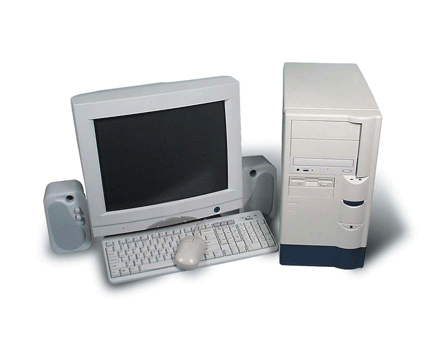
Micro Computers
Those computers that use microprocessor as their central processing unit and are the smallest of the types are the microcomputers. Microcomputers are often called personal computers (PCs) because they are intended to be used by a single person at a time. While mainframe and mini computers can support multiple users simultaneously, it can support only one user at a time.
Micro computers can further be classified into desktop computers (that can fit within the top of a desk), laptops (portable computers that can be operated on your lap) and palmtops (hand held computers).
Super Computers
There is another class of computers too! But I always feel it uncomfortable to list it as a class based on size. Oh! It does not fit anywhere?But there are a group of powerful computers known as Super Computers.
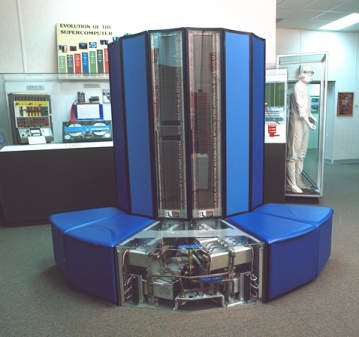
Super Computer - Cray I
Super Computers are the fastest type of computer and can be the largest too! Supercomputers are very expensive and are employed for specialized applications that require immense amounts of mathematical calculations. For example, weather forecasting requires a supercomputer. Other uses of supercomputers include animated graphics, fluid dynamic calculations, nuclear energy research, and petroleum exploration.
The chief difference between a supercomputer and a mainframe is that a supercomputer channels all its power into executing a few programs as fast as possible, whereas a mainframe uses its power to execute many programs concurrently.
Classification of computers based on Brand
Brands are specific names that companies use to identify their product against others in the market. There are many companies involved in computer manufacturing. However there are two classes of computers very different in principle itself – the IBM and the Macintosh. There are many other companies that follow the principle of IBM and are called IBM Compatible computers.
IBM PCs
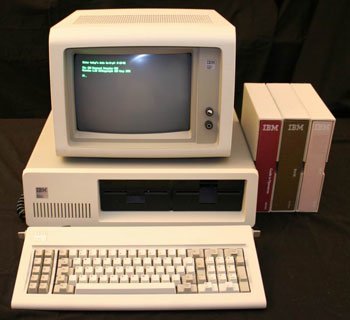
IBM PC 5150
These are the computers developed by IBM Company. After Thomas John Watson became president of Computing Tabulating Recording in 1914, he renamed it in 1924 as International Business Machines Corporation (IBM). In 1975 IBM introduced their first personal computer (PC) which was called the Model 5100. Later on IBM teamed up with Microsoft to create an operating systembecause their software division was not able to meet a deadline. They also teamed up with Intel to supply its chips for the first IBM personal computer. When the personal computer hit the market it was a major hit and IBM gained a strong power in electronic computers.
What identifies IBM computers is because of the UPU design. IBM computers use CISC (Complex Instruction Set Computing) CPUs. It uses the Intel chips for its PCs and relied to Microsoft for operating system.
Apple Macintosh Computers
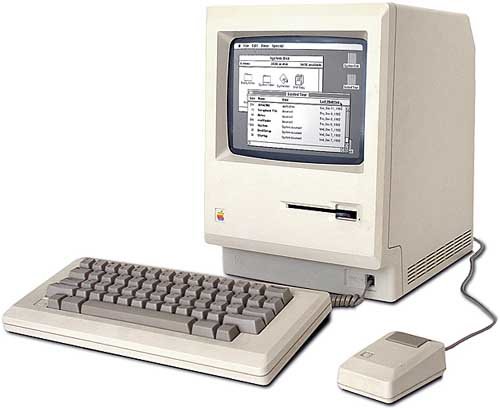
Apple Macintosh
Apple Company was founded by Steve Jobs and Steve Wozniak in 1976. For about $700 someone could buy a computer that they put together, which was called the Apple I. In 1977 the Apple II was introduced. Apple was trying to appeal more to the business world so they designed the Lisa computer that was a prototype for the Macintosh and it cost around $10,000. It featured a ‘never before seen’ graphical interface and the mouse. In 1984, they launched the Macintosh.
IBM used Motorola chips and created a RISC (Reduced Instruction Set Computing) CPU that could run faster than the CISC model of the same MHz rating, so a RISC chip with a MHz rating of 100 could run just as fast as a CISC chip with MHz rating of 133.
Compatible Computers

IBM Compatible PCs
Phoenix Technologies went through published documentation of IBM PC to figure out the internal operating system (BIOS) in the IBM. In turn, they designed a BIOS of their own which could be used with IBM computers. Many manufacturers jumped in and started making their own IBM Compatible computers. So, there is a class of computers that work in the same principle as that IBM PCs but are developed by other companies. These computers are generally known as Compatible Computers.
Classification of Computers based on Model
We can still classify computers based on another aspect – model. There are three different models of computers already available – XT computers, AT computers and PS/2 computers.
Extended Technology or XT
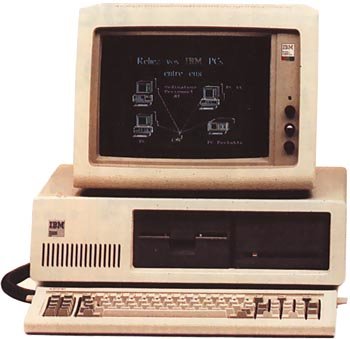
IBM PC XT (IBM 5160)
The extended technology computers used 8006, 8008, 8086, 8088 processors (These are the names of Microprocessors). The period of these computers was from 1975 to 1982. These processors had 4.77 MHz clock speed (these days there are Gigahertz computers). The processors were all of 8-bit. These computers are outdated now by two reasons: first, they do not support the latest software and the second that they had low processing power as well as low storage capacity.
Advanced Technology or AT
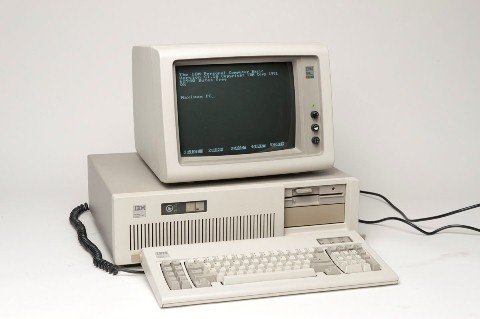
IBM PC AT
With the advent of 80286 microprocessors in 1982, Advanced Technology computers were introduced. The processors were of 8-bit and 16-bit. The computers using processors like 80286, 80386, and 80486 are the examples. Advanced Technology computers’ period is from 1982 to 1995. With the features of higher speed and larger memory than the XT computers, they support latest versions of available software.
AT computers may have 80286 SX or 80387 DX, 80486 SX, 80486 DX or even Pentium (80586) processors. The AT computers support Co-processor that enhances the processing speed and capability of the main processor to perform large and computations within a short period.
Personal System or PS/2
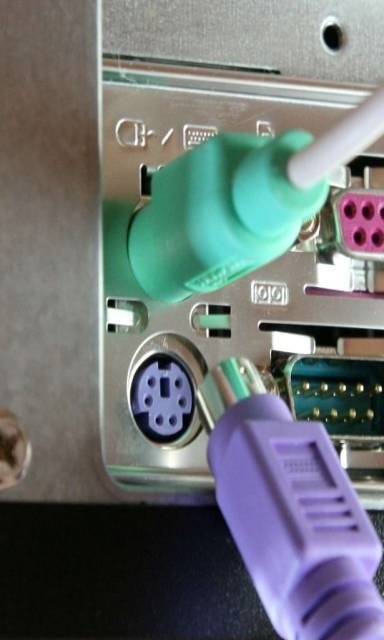
PS/2 Pc
With the advancement of Processors having high clock speed as well as high storage capacity, IBM developed the second generation of personal computers in early 1990s, which used new refined architecture making the computers faster and more powerful than AT computers. The PS/2 processors used VLSI (Very Large Scale Integration) for chip fabrication and their clock speed range from 85 MHz to 1GHz. Generally, PS/2 Computers use 3.5 inch floppy disks and OS/2 operating System. PS/2 computers are widely used in general purpose computation such as word processing, Database Arrangement, Controlling accounts etc.
Points to Remember
- Computers can be classified into different groups according to different categories such as principle or application, size and brand.
- Analog, Digital and Hybrid are the three classes of computers based on the principle of work.
- Super, Mainframe, Mini and Micro are the different classes of computers based on the size.
- Apple/Macintosh, IBM PCs, Compatibles are the classes of computers based on the brand.
- Analog computer works by processing the continuous analog signals such as heat, pressure, speed etc.
- Digital computer works by processing the discrete data.
- Digital computers can be divided into two classes – general purpose and special purpose.
- Hybrid computers can accept analog signals or digital data to process and produce results.
- Super computer is the largest and the most powerful computer. Its speed is generally measured in FLOPS (Floating Point Operations Per Seconds)
- Mainframe computer is often referred as “big iron”. Supercomputer can perform a task in really faster speed but mainframe computer can support largest number of tasks in a time instance.
- Minicomputer is medium sized computer and thus suitable for large organizations, universities and research institutes.
- Microcomputers are the smallest computers. They range from desktop PCs to laptops, notebooks, palmtops, wearable and pocket computers.
- Computers manufactured by IBM Company are known as IBM PCs. Apple Company produced Apple and Macintosh computers. All other manufacturers who produced computers based on IBM PC principle are known as compatibles.
Leave a Reply